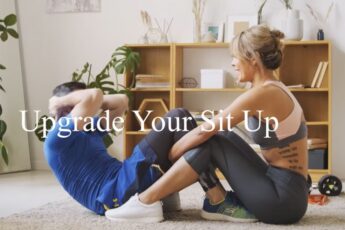Last Updated on November 16, 2023 by Local Trainer
Get ready to ignite your core and take your fitness to the next level with these 25 highly effective functional exercises. Whether you’re an athlete looking to enhance your performance or someone simply wanting to strengthen and tone your midsection, these exercises have got you covered.
Incorporating a variety of movements that target different aspects of your core, these exercises will not only help you build a strong and stable midsection but also improve your posture, balance, and overall functional strength. From planks and Russian twists to mountain climbers and flutter kicks, this comprehensive list has something for everyone.
But why settle for basic crunches when you can challenge your core with dynamic and engaging exercises that mimic real-life movements? Say goodbye to boring and repetitive routines and say hello to a strong, functional, and aesthetically pleasing core.
So, are you ready to set your core on fire? Let’s dive into these 25 highly effective functional exercises that will leave you feeling stronger, more balanced, and ready to conquer any challenge that comes your way.
Benefits of incorporating functional exercises for the core
Having a strong core goes beyond just having visible abs. The core muscles, which include the rectus abdominis, transverse abdominis, obliques, and lower back muscles, play a crucial role in stabilizing the spine and transferring force between the upper and lower body. Incorporating functional exercises that target these muscles can provide numerous benefits.
Firstly, functional exercises engage multiple muscle groups simultaneously, mimicking the movements we perform in our daily lives. This trains the core to work as a unit, improving overall coordination and stability. Functional exercises also help improve posture, as a strong core supports a straight spine and reduces the risk of back pain or injuries.
Additionally, functional core exercises can enhance athletic performance. Whether you’re a runner, a weightlifter, or a team sports player, a strong and stable midsection is essential for generating power and transferring force efficiently. By incorporating these exercises into your training routine, you can improve your speed, agility, and overall athletic performance.
Anatomy of the core muscles
Before diving into the exercises, it’s important to understand the anatomy of the core muscles and how they function. The core is a complex network of muscles that work together to provide stability and support for the entire body.
The rectus abdominis, commonly referred to as the six-pack muscles, runs vertically along the front of the abdomen. These muscles primarily assist in trunk flexion and are responsible for creating that coveted washboard appearance.
The transverse abdominis, often referred to as the body’s natural corset, wraps around the abdomen like a belt. This muscle plays a vital role in spinal stability and acts as a deep stabilizer for the entire core.
The obliques, both internal and external, are located on the sides of the abdomen. They allow for trunk rotation and lateral flexion, helping to create a strong and balanced core.
Lastly, the lower back muscles, including the erector spinae and multifidus, provide support and stability to the spine. These muscles work in conjunction with the abdominal muscles to maintain proper posture and prevent lower back pain.
Understanding the different muscles of the core and their functions will help you better target them during your functional exercises, ensuring maximum effectiveness and results.
Common core training mistakes to avoid
While incorporating functional exercises into your core training routine can be highly beneficial, it’s important to avoid common mistakes that can hinder your progress. Here are some key mistakes to steer clear of:
1. Neglecting proper form: It’s crucial to maintain proper form and technique during each exercise to effectively engage the core muscles. Avoid rushing through the movements and focus on quality over quantity.
2. Overtraining: While it’s important to challenge your core, overtraining can lead to muscle imbalances, fatigue, and increased risk of injury. Allow for adequate rest and recovery between workouts.
3. Not progressing gradually: Start with foundational exercises and gradually progress to more advanced variations as your strength and stability improve. Rushing into advanced exercises without a solid foundation can lead to poor form and potential injuries.
4. Ignoring other muscle groups: While the core is the main focus, it’s essential to incorporate exercises that target other muscle groups as well. A balanced training program ensures overall strength and stability.
5. Not incorporating variety: To continuously challenge your core, it’s important to introduce new exercises and variations into your routine. This prevents plateaus and keeps your workouts engaging and effective.
By avoiding these common mistakes and focusing on proper form, gradual progression, and variety, you can optimize your core training and achieve the best results.
5 foundational functional exercises for the core
1. Plank: Start by assuming a push-up position, but with your forearms resting on the ground. Engage your core, squeeze your glutes, and hold this position for as long as possible while maintaining a straight line from your head to your heels. The plank is an excellent exercise for overall core stability.
2. Dead Bug: Lie on your back with your arms extended toward the ceiling and your legs bent at a 90-degree angle. Slowly lower one arm behind your head while simultaneously straightening the opposite leg. Return to the starting position and repeat on the other side. The dead bug targets the deep stabilizing muscles of the core.
3. Bird Dog: Begin on all fours with your hands directly under your shoulders and your knees under your hips. Extend one arm forward while simultaneously extending the opposite leg behind you. Hold for a few seconds, then return to the starting position and repeat on the other side. The bird dog improves core stability and balance.
4. Russian Twist: Sit on the ground with your knees bent and your feet flat on the floor. Lean back slightly and lift your feet off the ground, balancing on your sit bones. With a straight back, twist your torso to one side, touching the ground with your hand. Return to the center and repeat on the other side. The Russian twist targets the obliques and improves rotational strength.
5. Superman: Lie face down on the ground with your arms extended in front of you and your legs straight. Lift your arms, chest, and legs off the ground simultaneously, squeezing your glutes and lower back muscles. Hold for a few seconds, then lower back down. The Superman exercise targets the lower back muscles and improves overall core strength.
5 intermediate functional exercises for the core
1. Mountain Climbers: Start in a push-up position with your hands directly under your shoulders. Drive one knee towards your chest, then quickly switch legs in a running motion. Continue alternating legs as fast as possible while maintaining core stability. Mountain climbers provide a great cardiovascular and core workout.
2. Side Plank: Begin by lying on your side with your forearm on the ground and your feet stacked on top of each other. Lift your hips off the ground, creating a straight line from your head to your heels. Hold this position for as long as possible, then repeat on the other side. Side planks target the obliques and improve lateral stability.
3. Hanging Leg Raises: Find a pull-up bar and hang with your arms fully extended. Engage your core and lift your legs up towards your chest, then slowly lower them back down. To increase the difficulty, you can perform the exercise with straight legs. Hanging leg raises strengthen the lower abs and improve grip strength.
4. Bicycle Crunches: Lie on your back with your hands behind your head and your legs bent at a 90-degree angle. Lift your shoulder blades off the ground and bring one knee towards your chest while simultaneously extending the other leg. Twist your torso, bringing your opposite elbow towards the bent knee. Repeat on the other side. Bicycle crunches target the obliques and rectus abdominis.
5. Medicine Ball Slams: Stand with your feet shoulder-width apart, holding a medicine ball above your head. Engage your core, and with force, slam the ball down onto the ground. Catch the ball on the rebound and repeat for the desired number of repetitions. Medicine ball slams improve core power and explosiveness.
5 advanced functional exercises for the core
1. Dragon Flags: Lie flat on a bench or the ground with your hands gripping the edge behind your head. Engage your core and lift your legs and torso off the ground as one unit, keeping your body straight. Slowly lower back down, maintaining control throughout the movement. Dragon flags challenge the entire core.
2. L-sit: Sit on the ground with your legs straight out in front of you. Place your hands on the ground next to your hips, fingers pointing forward. Press through your hands and lift your hips off the ground, keeping your legs straight and parallel to the ground. Hold this position for as long as possible. The L-sit targets the entire core and requires significant strength and stability.
3. Pike Push-ups: Start in a push-up position with your feet on an elevated surface, such as a bench or a stability ball. Walk your hands back towards your feet, lifting your hips and creating an upside-down “V” shape with your body. Lower your head towards the ground by bending your elbows, then push back up to the starting position. Pike push-ups engage the core and target the shoulders.
4. Renegade Rows: Begin in a push-up position with a pair of dumbbells in your hands, wrists aligned with your shoulders. Perform a push-up, then lift one dumbbell off the ground and row it towards your hip, keeping your core stable. Lower the dumbbell back down and repeat on the other side. Renegade rows challenge the core and upper body.
5. Hanging Windshield Wipers: Hang from a pull-up bar with your arms fully extended. Engage your core and slowly rotate your legs from side to side, keeping them straight and parallel to the ground. The hanging windshield wipers are an advanced exercise that targets the obliques and requires exceptional core strength and control.
Combining functional exercises for a full core workout
While each exercise targets specific aspects of the core, combining them in a structured workout can provide a comprehensive training session. Here’s an example of a full core workout:
1. Plank: Hold for 60 seconds.
2. Dead Bug: Perform 10 reps on each side.
3. Bird Dog: Hold for 10 seconds on each side, performing 10 reps.
4. Russian Twist: Perform 15 reps on each side.
5. Superman: Hold for 30 seconds.
6. Mountain Climbers: Perform 20 reps on each side.
7. Side Plank: Hold for 30 seconds on each side.
8. Hanging Leg Raises: Perform 12 reps.
9. Bicycle Crunches: Perform 20 reps on each side.
10. Medicine Ball Slams: Perform 15 reps.
Performing this workout two to three times per week, while gradually increasing the intensity or number of repetitions, will help you build a strong and functional midsection.
Tips for proper form and technique in functional core exercises
To maximize the effectiveness of your functional core exercises and minimize the risk of injury, it’s crucial to maintain proper form and technique. Here are some tips to keep in mind:
1. Engage your core: Before starting any exercise, consciously engage your core by pulling your belly button towards your spine. This helps stabilize your spine and ensures the targeted muscles are being activated.
2. Maintain neutral spine alignment: Keep your spine in a neutral position, avoiding excessive rounding or arching. This promotes proper alignment and reduces the risk of strain or injury.
3. Breathe: Remember to breathe throughout each exercise. Exhale during the exertion phase and inhale during the relaxation phase. This helps maintain oxygen flow and stability.
4. Start with lighter weights or bodyweight: If you’re new to functional core exercises, begin with lighter weights or focus on bodyweight exercises. As you build strength and stability, gradually increase the resistance or difficulty.
5. Listen to your body: Pay attention to any discomfort or pain during the exercises. If something doesn’t feel right, adjust your form or seek guidance from a qualified fitness professional.
By following these tips, you can perform functional core exercises safely and effectively, maximizing your results and minimizing the risk of injury.
Conclusion and final thoughts on mastering your midsection with functional exercises
When it comes to developing a strong and functional midsection, traditional crunches are just the tip of the iceberg. By incorporating a variety of functional exercises that engage the core in dynamic and challenging ways, you can take your core training to a whole new level.
From foundational exercises like planks and dead bugs to advanced movements like dragon flags and hanging windshield wipers, there are endless options to keep your core workouts exciting and effective.
Remember, mastering your midsection goes beyond aesthetics. A strong and functional core improves overall athletic performance, enhances posture and balance, and reduces the risk of injuries and back pain.
So, don’t settle for mediocrity. Ignite your core with these 25 highly effective functional exercises and unleash the full potential of your midsection. Your core is your foundation, and with the right training, it can set you up for success in all areas of your fitness journey.
Are you ready to rise above the ordinary and set your core on fire? Embrace the challenge, stay consistent, and let your core become a force to be reckoned with. Get ready to reap the rewards of a strong, functional, and aesthetically pleasing midsection. Your core is waiting for you to unlock its full potential.
Local Trainer






